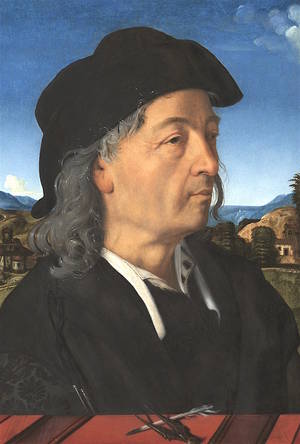The current exhibition (on until 20th August) of drawings by Giuliano da Sangallo and his circle at the Gabinetto dei Disegni e delle Stampe (the Prints and Drawings Collection) on the first floor of the Uffizi provides an interesting and peaceful interlude if you are planning to visit Florence in this over-crowded season. The exhibition is free: if you state your destination to one of the staff members organizing the queues outside, you will be let straight in.

Giuliano (Giuliano Giamberti, c. 1445–1516) was an architect who worked for the Medici as well as the Papacy, designing palaces, villas, churches and military fortifications. All the drawings on show, except for two from the Albertina in Vienna, are from the Uffizi collection itself.
In the small room opening onto the stair landing is Giuliano’s wooden model of Palazzo Strozzi, a remarkable survival (and usually on display in the palace itself). For this exhibition it has been taken apart so that the rooms inside all three floors can be seen. A fascinating 15th-century ‘doll’s house’, it would have been available to the builders as they laid stone after stone of this great Renaissance palace. An excellent black-and-white video on the wall here illustrates the buildings Giuliano was responsible for in Florence and Tuscany. Also here are two drawings by Francesco da Sangallo (Francesco Giamberti, 1494–1576), Giuliano’s son, one for the convent of the Cestello (now Santa Maria Maddalena dei Pazzi), and a drawing on parchment of the Baths of Diocletian, this once magnificent ancient building (still very conspicuous near Rome’s main railway station), signed and dated 1518.
The main exhibition room has some works produced jointly by the two brothers Giuliano and Antonio da Sangallo the Elder (Antonio Giamberti; c. 1455–1534) and studies of buildings of ancient Rome including the ground plan of a temple found on the Quirinal hill by Francesco da Sangallo, and an elevation of the frigidarium of the Baths of Diocletian and a ground plan of the entire area of the baths by Antonio da Sangallo the Elder. The Libro dei Disegni owned by the Uffizi, which contains more studies of the Antique by Giuliano and Antonio the Elder’s nephew, known as Antonio da Sangallo the Younger (Antonio Cordini, 1484–1546), is also on display.
Giuliano’s famous contemporary Bramante (Donato di Angelo di Pascuccio, 1444–1514) is present in the exhibition with another plan of the Baths of Diocletian furnished with meticulous measurements, and his first thoughts on the architecture of St Peter’s, sketched in red chalk, clearly showing his uncertainty. On one of these sheets there is a bold drawing on the verso by Giuliano da Sangallo demonstrating how closely the two architects were at work during one stage in the long building saga of the great basilica. A larger, more finished parchment drawing shows Bramante’s idea for part of the east end of St Peter’s, and there is a project for the same church by Fra’ Giocondo (Giovanni Giocondo da Verona; before 1434–1515), whom we know was also called in to suggest a possible Latin-cross design.
Some of the most interesting drawings by Giuliano include a fanciful design for embellishing the Borgia tower in the Vatican, complete with flower pots on its balustrade; and one of a church façade which includes numerous reliefs (all carefully drawn), statues in niches and free-standing figures above.
His project for the Florentine church of San Lorenzo, celebrating Leo X, is crowned by a statue of St Peter above the tympanum with its pair of Florentine lions. Giuliano also envisaged free-standing statues for this façade, but was clearly uncertain how many there should be. But the over-all design is extremely harmonious, which cannot be said for the project displayed next to it, drawn by Antonio da Sangallo the Elder, which has a pair of bell-towers rising to twice the height of the façade.
A section devoted to Giuliano’s very fine figure studies for the story of Judith and Holofernes has two sheets drawn on the verso as well as the recto. Antonio da Sangallo the Elder made copies of the saints on Donatello’s bronze doors of the Old Sacristy in San Lorenzo (represented here by two more drawings) and he also copied a detail of Giovanna Tornabuoni in a painting by Botticelli (now in the Louvre). Only one painting is present in the exhibition, a tondo of the Madonna and Child attributed to the workshop of Botticelli, which has been lent by the National Gallery of London since it appears to have been owned by Giuliano.
The two codices which contain the most precious drawings by Giuliano outside the Uffizi, the Taccuino senese (still in Siena) and the Libro dei Disegni in the Vatican library, can be consulted at the exhibition in digital format (although the video was not working on my second visit).
The arrangement of the drawings, it must be said, is not always easy to follow and it is a pity that no dates, even if conjectural, were added to the labels. Also, the complicated relationship between the various artists that share the name Sangallo (apparently derived from the district of Florence near the Porta Sangallo, where some of the family lived) is nowhere fully explained. Notwithstanding all this, the exhibition provides us with a visual conception of how the various designs produced in the 15th century for St Peter’s would have looked, and it illustrates the concerted efforts to provide Florence’s San Lorenzo with a façade before Michelangelo won the competition in 1516 (only to have Leo X cancel the commission when the great artist was already at work on it, to his great chagrin; the story is told in full, and illustrated, in the new edition of Blue Guide Florence. The architects represented in this exhibition all appear frequently in the Florence, Rome and Central Italy Blue Guides so this has also provided us with a chance to check their dates and the latest attributions.
by Alta Macadam.






